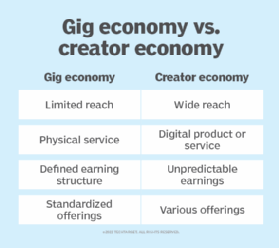
Gig economy vs. creator economy: What's the difference?
With digital platforms and work flexibility, people are finding new ways to earn money. Two types of economies -- gig and creator -- offer alternative ways to make an income.
As people look for new ways to make money, new types of economies emerge. Two popular types include the gig and creator economies, and while they might seem similar, they do have their differences.
The rise in various types of economies -- such as gift economy, sharing economy, barter economy, gig economy and creator economy -- is part of a shift in the business culture as work becomes more remote and flexible. Work can be completed remotely through various digital platforms. Freelancers can accept jobs from any location, and creators have access to more platforms to increase reach to potential consumers.
The gig and creator economies offer many ways for a person to earn money.
What is the gig economy?
A gig economy is a type of labor market with temporary and part-time positions offering short-term commitments. Gig workers -- consisting of independent contractors and freelancers -- choose independence and flexibility over job security. These workers are paid by a company for their project or task, but receive no other benefits, such as paid time off or health insurance.
The term gig comes from the music industry, where the term describes a booked performance. A gig is a job that only lasts a certain period of time.
The gig economy consists of consumers, workers and companies. The workers are paid per task, project or work contract. Freelancers choose gig jobs to help find their next sources of income without having to search on their own.
Consumers turn to gig economy apps for convenience and service. Apps such as Uber, Grubhub and Instacart are all part of the gig economy. They meet customer demands and offer a task for gig workers. Gig workers can choose to take available jobs or to pass, making their own schedule and pay.
The global gig economy is estimated to grow by 17.4% and be valued at $455 billion by the end of 2023, according to a Mastercard report. By 2027, about 50% of the U.S. population will have participated in gig work, Statista projected.
What are gig jobs?
Job categories that fall under gigs include the following:
- food delivery
- freelance writing
- accounting
- substitute teaching
- construction trades
- photography
- grocery shopping
- transportation services
- administrative tasks
- graphic design
- music
- software development
Learn more about working as a freelance software developer.
What is the creator economy?
The creator economy -- sometimes referred to as passion economy -- is another type of marketplace for individuals to use their creativity and skills to build their own brand and community.

As the term implies, they create their own work, such as writing a blog, offering coaching services or filming for a YouTube channel. They use the internet to share their ideas and work. Digital platforms such as YouTube and Shopify allow individuals to reach others to share their information, experiences or products.
Creators use social networks to guide their fans or community to their personal websites or apps. The creators are the founders of this type of economy, and they choose what they're selling, whether it's advice, product, experience or service. The creator economy is based on connections with individual personalities rather than a branded company.
There are more than 50 million people globally who consider themselves creators, according to data from SignalFire.
What are creator jobs?
Creator jobs are run by entrepreneurs who develop their own plans, products and services. These offerings are available on digital platforms to consumers. Here are some examples of creator economy jobs:
- fitness trainer
- dietitian
- artist
- product or craft creator
- course creator
- life coach
- musician
- blog writer
- video blogger, e.g., YouTuber
Creators earn money through the following ways:
- sponsored content
- product placement
- digital content sales
- merchandise
- tipping
- advertising revenue
- paid subscriptions
- live events
- fan clubs
What's the difference between the gig economy vs. the creator economy?
In a creator economy, the creator develops content for a specific audience and forms a relationship. Creators work directly with their audience to meet their needs when developing content. The gig economy doesn't have the same personal touch. The gig economy offers standardized services.
The creator economy is up to the business owner, and products or services are not standardized. Creator economies typically offer a digital product or service and do not have a limited reach. The earnings can be less predictable than with gig economies. Gig economy jobs have well-defined earnings structures since they are run by a company rather than by individuals.
In a gig economy, the consumer makes a short-term commitment to buy a physical service. In a creator economy, the consumer builds a relationship and might continue to use their services or products.








